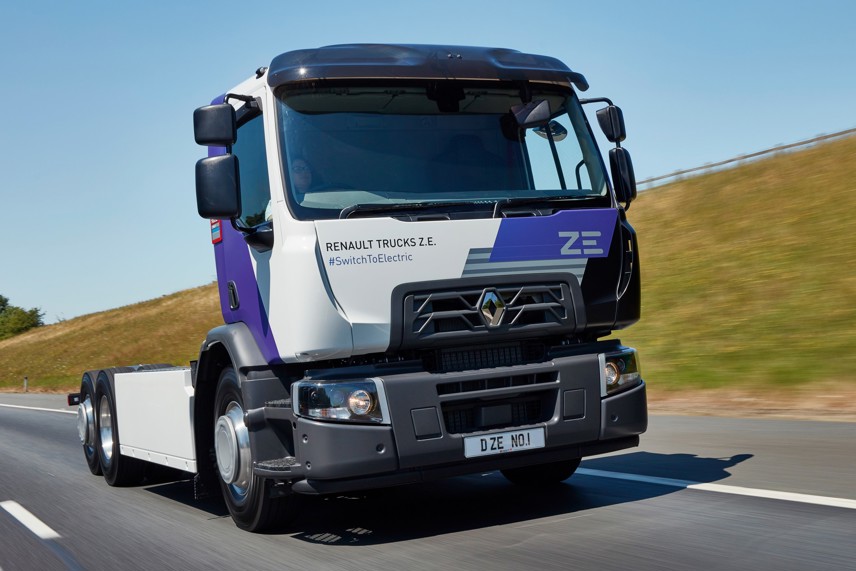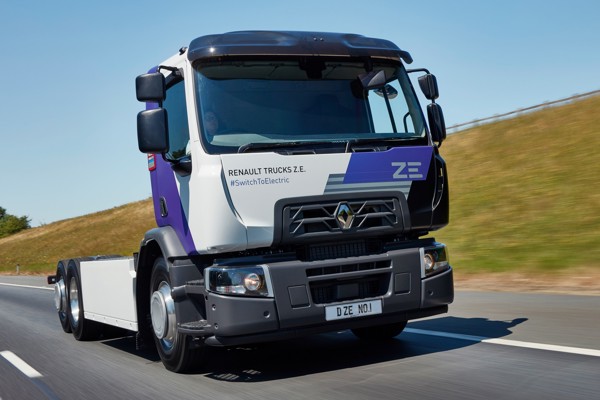Review
With the commercial vehicle industry in alternative fuel turmoil, and nearly as many new players entering the arena as “legacy players”, the next 10-to-15 years is set to be interesting mix of the old and new.
To the casual observer, it should be fun watching the transition from diesel to electric in the road transport sector. But, if you are in the business of running trucks for a living and, more importantly, doing it profitably or at least within a known budget, fun is not the first word that comes to mind.
The first mainstream truck manufacturer to electrify a multi-wheeler and have it operating in the UK is Renault Trucks with its D Range ZE (no points for guessing what the ZE stands for). It launched the first electric D Range in 2017 and there are now two zero-emission models, a two axle 16-tonne gross vehicle weight (GVW) rigid and a 26-tonne GVW three-axle multi-wheeler. Commercial Fleet was invited to test-drive the latter which has a claimed range of up to 112km in a distribution application.
Of course, the main components of the battery driveline consists of the batteries and the motor (if we exclude the battery management system etc) and the 6x2 D range has two motors, unlike its 16-tonne two-axle ‘cousin’ which has one. They are exactly the same specification, combined they are rated at a maximum power of 507PS (370kW) with continuous power of 355PS (260kW) and a maximum torque of 850 Nm. The 16-tonne version is half of these figures and the motors are mounted either side of the battery packs.
The battery packs are rated in steps of 49kWh and the 26-tonner has four of these mounted on either side of the chassis rated at 30 amperes, offering a nominal 200kWh total capacity.
Upgrades expected soon
We believe Renault Trucks will be upgrading these in a short while to 66kWh packs rated at 40 amperes within the same footprint, which fits with their other battery packs in the light commercial vehicle range which have 33kWh packs.
This means there is the potential to take the maximum battery capacity up to 400kWh on the two-axle rigid, allowing for either greater range or perhaps powering ancillary equipment and retaining the same range. Coupled to the batteries and motor is a two-stage transmission delivering power to a conventional rear axle.
Interestingly, Renault Trucks is also specifying an electronic power take-off (e-PTO).
We can’t mention the batteries without talking about the charging system and the 6x2 has a 22kW onboard charger (20kW on the 4x2) as standard. They are charged either via a conventional Type 2 AC connector or a CCS Combo 2 rapid DC charger, with AC charge times up to 80% between 8-12 hours, dependent on battery configuration and around two hours on DC, again dependent on the charger rating and battery configuration.
The 6x2 ZE D range is available on the 3,900mm wheelbase model and is measured from the centreline of the front axle to the centreline of the second axle, and the rear bogie spread is 1,350mm.
The front axle is rated at 8,000kgs and to the rear of the electric motors everything looks reasonably conventional, as a 6x2 fixed rear steer the second axle is the drive axle rated at 11,500kgs and the steered third axle is rated at 7,500kgs. All axles have 315/80R22.5 tyres.
The front suspension is on air with stabiliser bars and has a kerbweight of 5,315kgs, the rear axle has full air and a kerbweight of 4,084kgs, resulting in a full chassis kerbweight of 9,399kgs allowing for a potential body and payload of 16,601kgs
Braking with electric vehicles always starts with the regeneration and the D Range has five levels controlled via the column-mounted stalk.
It’s worth noting that, even in the lowest level, the regeneration is set to replicate the engine braking of a diesel. This is supplemented by the more traditional all-round disc brakes. Of course, software and electronics play their part as well, and the D Range has emergency brake assist, hill-start assist, anti-lock braking, anti-slip regulation and electronic stability control. Advanced driver systems also include lane-departure warning and adaptive cruise control linked to the advanced emergency braking system.
As befits a mainly urban delivery-type truck a day cab is standard and, in our case, it was the wide version measuring 2,090mm and 1,344mm deep. The hydraulic tilt cab is mounted on a four-point mechanical suspension system and features two heated and remote controlled door mirrors and a passenger side vision window on the lower half of the door.
Inside, there’s a air-suspended driver’s seated complete with lumber support, heated cushion and seatback as well as an armrest. Upper storage cupboards with nets plus a couple of more cupboards supplemented by bins on the engine tunnel complete the available storage.
Little difference inside
Approaching the D range you certainly notice the large ZE logos around the vehicle and the bank of batteries on either side of the chassis instead of the normal fuel tanks carrying all the diesel.
Stepping into the cab and glancing round it looks like any other D range we have driven, and perhaps that’s a good thing, its just when you look at the instrument panel and you see a different set of dials that you realise it’s electric.
There’s a large central dial with charge on the left and power on the right and a needle at 12 o’clock, to the left are three smaller dials for air pressure, battery condition and ‘eco’ performance. On the right is an LCD screen with information such as tacho hours etc. and range, battery condition and the like are shown in the centre below the main dial.
Switching on is a simple matter of turning the keys clockwise and waiting for the hum of the batteries, then release the park brake.
The experience is no different to driving an electric car or van, it’s quiet compared with a diesel and the driving style demands a relaxed manner.
We drove along a mixture of road-types including the dual carriageways and urban roads. The combination of almost silent movement and the braking via steering wheel column stalk for braking regeneration made the journey a pleasure.
Renault Trucks is proud of its ZE models and, driving the D Range, we can see why. There can be no doubt that electric will be the future of urban delivery trucking and you can try it now on UK roads.
Provided the vehicle is charged at up to 22kWh AC or 150kWh DC, the battery performance will be guaranteed – 125kWh after 10 years or total energy output of 250kWh, whichever comes first (four battery pack installation).

















